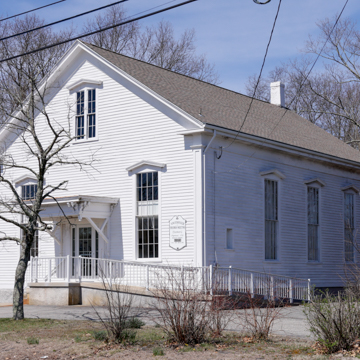John Arnold and other Quakers in the vicinity of Union Village erected the first religious building in northern Rhode Island on this site (then on Great Road) in 1721. It burned in the early 1880s, and this is its replacement. Plain for its period, it appears to be at least twenty or thirty years older than it is. But compared to the even more modest mien of earlier meeting houses, this one is unusual in Rhode Island for the scale of its windows and especially for the bold projection of its almost flat-roofed, sparely braced and bracketed shelter over the entrance. This assertiveness is countered by a certain gentleness in the sheltering quality of the hood over the pyramid of granite stairs and in the restrained handling of even the most Victorian aspects of the design. The delicacy of molding for cornice, paneling of corner boards, and the gentled labels is positively un-Victorian, as is the taut linearity of the window sash. Quaker decorum holds Victorian ostentation in check. An unprepossessing cemetery is gathered around the building. Opposite, Union Cemetery serves the village. Between them they contain graves extending back to the early settlement of this place and through the generations who subsequently inhabited it.
You are here
Friends Meeting House
If SAH Archipedia has been useful to you, please consider supporting it.
SAH Archipedia tells the story of the United States through its buildings, landscapes, and cities. This freely available resource empowers the public with authoritative knowledge that deepens their understanding and appreciation of the built environment. But the Society of Architectural Historians, which created SAH Archipedia with University of Virginia Press, needs your support to maintain the high-caliber research, writing, photography, cartography, editing, design, and programming that make SAH Archipedia a trusted online resource available to all who value the history of place, heritage tourism, and learning.




















